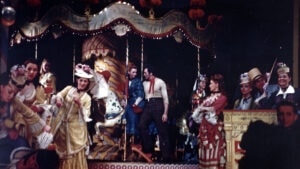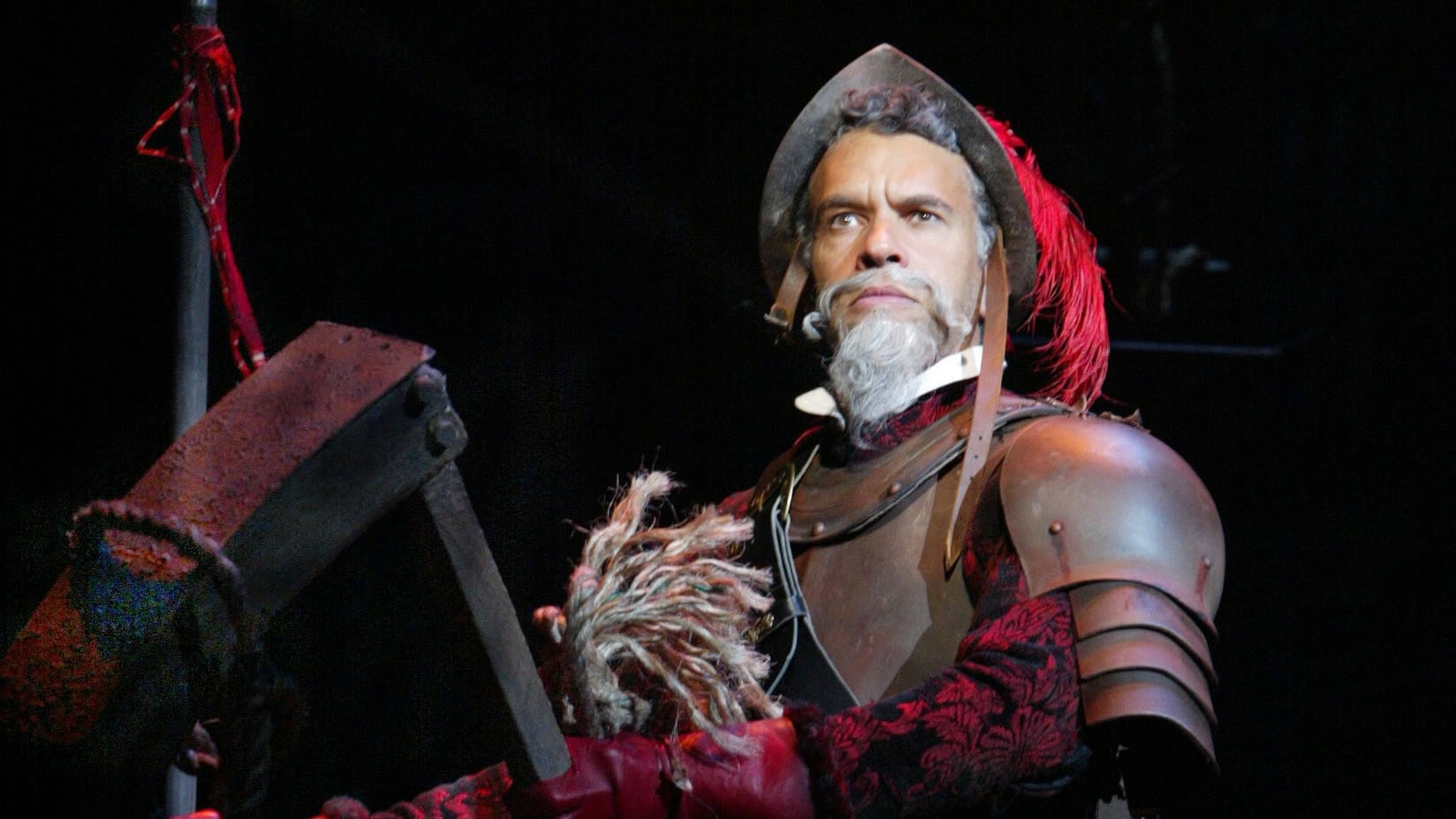
Hailed as one of the great masterpieces of Golden Age musical theatre, Rodgers & Hammerstein’s Carousel (US/UK) remains a shining example of sophisticated dramatic storytelling through music and song. But the Carousel we know and love today, 80 years after it was written, is significantly different from the version that debuted at the pre-Broadway New Haven and Boston try outs in 1945. In fact, that version came close to being declared a flop, which would have halted the evolution of Carousel forever and, in turn, deprived us of a musical masterpiece.
When they began writing Carousel, Richard Rodgers and Oscar Hammerstein II were coming off the resounding success of their first collaboration, Rodgers & Hammerstein’s Oklahoma! (US/UK). The show’s popularity was so overwhelming that both men were wary of producing anything else that might diminish its shine. While Oklahoma! rocketed the composing duo to stardom, it also ratcheted up the pressure to deliver a follow-up hit. To their credit, Rodgers & Hammerstein took their time to find a story they felt had the potential to fulfill this daunting task. Before returning to their collaboration, each focused on individual projects, with Hammerstein writing Carmen Jones (US/UK), a modern adaptation of Bizet’s opera Carmen, and Rodgers completing his final project with Lorenz Hart, a revival of A Connecticut Yankee (US/UK).
While Rodgers & Hammerstein were busy with these other projects, Theresa Helburn, co-founder of the Theatre Guild and producer of Oklahoma!, was painstakingly searching for material that the team could adapt into another hit. She landed on a musical adaptation of the 1909 play Liliom (US/UK) by Hungarian playwright Ferenc Molnár. Liliom appealed to audiences following the First World War and was adapted into a 1934 film starring Charles Boyer. Set in Budapest, the play followed carnival barker Liliom, who shocked audiences by dying after a botched robbery halfway through the play, leaving his wife and daughter to pick up the pieces. Helburn presented the idea in 1943 at her weekly “gloat lunch” with Rodgers & Hammerstein, who were not initially enthused. Helburn floated the idea of changing the setting, initially suggesting New Orleans. The composing duo agreed to consider it.
After several weeks of research, they settled on New England in the late 19th century as the most promising setting for their adaptation. Hammerstein began to envision an ensemble of “sailors, whalers, girls who worked in the mills up the river” and warmed greatly to the idea. After several weeks of thought and research, the pair agreed with Helburn that “while the play was a challenge, it would be an inspiring one to meet.” With Rodgers & Hammerstein now on board, a new challenge had to be overcome, and quite a substantial one: Playwright Ferenc Molnár was staunchly set against his play being musically adapted, having already turned down Puccini’s request to adapt Liliom into an opera. This apparent dead end didn’t deter the pair, however. They invited Molnár to see a sold-out performance of Oklahoma! and he agreed to the adaption the very next day.

1945 Broadway production of Rodgers & Hammerstein’s Carousel (from the R&H Archives)
With Molnár’s blessing, Rodgers & Hammerstein began the challenging task of adapting the delicate drama into an effective musical. While they were furiously writing, the Drama Guild began the task of raising the $180,000 budget which, due to the success of Oklahoma!, proved an easier task than expected. By 1945, the partners had completed their first pass at this challenge and had assembled a creative team featuring choreographer Agnes de Mille and director Rouben Mamoulian, both of whom had worked on Oklahoma!, plus the relatively new actors Jan Clayton and John Raitt for the leading roles of Julie and Billy. (Raitt had taken over the role of Curly in the national tour of Oklahoma!, and after hearing his iron-clad baritone, Rodgers composed the eight-minute “Soliloquy,” in which Billy navigates the complex emotions of becoming a father.) With their main actors in place, the creative team slow assembled the rest of the cast.
As casting continued, Rodgers & Hammerstein proceeded with revisions on the book. Hammerstein remained convinced that the ending of the show needed to change to something more uplifting than Molnár’s original ambiguous ending. Unlike Liliom, who is immediately expelled from earth, Carousel’s Billy is granted a final moment to finally tell Julie, “I loved you, Julie. Know that I loved you!” As the reprise of the song “You’ll Never Walk Alone” soars through the theatre, an inescapable atmosphere of hope endures. This ending contrasted heavily with the original, and Rodgers & Hammerstein dreaded Molnár’s reaction. The playwright was invited to the first run-through, and the composing duo awaited his response with trepidation. The pair need not have worried. Molnár was ecstatic, declaring, “What you have done is so beautiful. And you know what I like best? The ending!”
Carousel moved to Boston for its second out-of-town tryout. But the Boston audience was not satisfied.
Having overcome the initial obstacle of Molnár’s approval, the next hurdle rose quickly to meet the production team. Carousel opened in New Haven on March 22, 1945 to a dire fact. Though set designer Jo Mielziner deemed it beautifully directed and one of the best musical-comedy scripts he’d ever read, the curtain came down at a run time of four hours. This was nearly 45 minutes too long, meaning drastic edits were needed. In a two-hour conference, the creative team made significant cuts to the second act, ultimately removing half of Agnes de Mille’s ballet (wherein Billy witnesses what has happened to his family since his death), a few complete songs, several choruses of others, and five scenes which haven’t seen the light of day since those performances.
With this new, shortened iteration, Carousel moved to Boston for its second out-of-town tryout, opening on March 27, 1945. But despite the musical’s standard run time, the Boston audience was not satisfied.
Hammerstein had created an alternate version of the afterlife in which Billy encounters two heavenly figures known only as “He” and “She.” In contrast to Molnár’s version which takes place in a magistrate’s court, Carousel’s Billy is transported to a New England parlor where he encounters who Hammerstein fondly referred to in an early draft as “a sort of Mr. and Mrs. God.” In a beautiful, proto-feminist scene, the following interaction between Billy and the two figures takes place:
BILLY. Who’s the lady?
HE. I suppose you are like all the others. You thought, when you arrived here, you’d have to deal only with a man.
BILLY. Yes, sir.
HE. Strange that the world doesn’t realize it needs a mother as well as a father.
Billy looks at She with new respect.
BILLY. Nobody ever told me, ma’am.
SHE. Don’t worry about it now, Billy. It takes time for people to get used to it.
The Boston critics did not want time to get used to such a transgressive reimagining of the afterlife, however, and roundly criticized the scene for being “just plain silly.” Elliot Norton of the Post even went so far as to call it “a concept which is theologically and dramatically foreign to the New England of Billy Bigelow and alien to the whole tone of the play.”
So Hammerstein gamely went back to the drawing board, quipping, “We gotta get God outta the parlor.” That evening, he crafted a fresh scene featuring the newly crafted character of the Starkeeper. Billy arrives at Heaven’s backyard, where a clothesline hung with stars stretches back into infinity and a stepladder shining with silvery light stands. A basket full of stars sits next to the Starkeeper, who can be seen “hanging out the stars and dusting them with a silver-handled white feather duster.” As this ambiguous figure polishes stars to be sent out across the sky to places that need them, he offers Billy Hammerstein’s trademark combination of bluntness, compassion and wit, ultimately creating a scene that is a charming cocktail of hope.
Though the Starkeeper and his backyard to Heaven were not the traditional representation of the afterlife, this lone male figure who resembled “a country doctor [or] minister” more closely aligned with expectations of the audience while still providing the whimsy and surprise Hammerstein needed for cohesive plot development. With this new scenario conceptualized, written and learned over a single night, the cast debuted the updated version the following evening. Audiences and critics alike responded favorably, giving us the iteration of the scene performed today.
By April 3, a week into the Boston run, Rodgers confidently wrote to his wife Dorothy, “Now I can write to you because we had a SHOW!” He was right. Opening night in New York was received with rhapsodic reviews for the entire creative team. The Daily News’ John Chapman wrote that Carousel was “one of the finest musical plays I have seen, and I shall remember it always.” His sentiment has carried forward across the decades.
The show remained Rodgers’ favorite to the end of his life. He said of it, “The whole subject matter cuts deeper. I feel it has more to say about human relationships. And I also think it’s the best score we’d ever written. I have more respect for it. I just like it better.” And who better to trust than the composer?
Learn more about the rich history of Rodgers & Hammerstein’s Carousel here.

“The Impossible Dream” – An Anthem of Hope

In the Spirit: Plays and Musicals Based on A Christmas Carol

